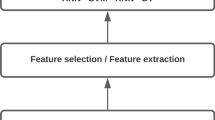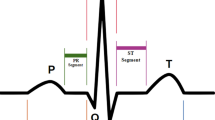Abstract
Dysrhythmia in gastric myoelectrical activity has been frequently observed in patients with gastric motor disorders and gastrointestinal symptoms. The assessment of the regularity of gastric myoelectrical activity is of great clinical significance. The aim of this study was to develop an automated assessment method for the regularity of gastric myoelectrical activity from the surface electrogastrogram (EGG). The method proposed in this paper was based on the filter bank and neural network. First, the EGG signal was divided into frequency subbands using filter bank analysis. Second, a parameter called the subband energy ratio (SER) was computed for each subband signal. A multilayer perceptron neural network was then used to automatically classify the EGG signal into four categories: bradygastria, normal, tachygastria, and arrhythmia, using the SER as the input. The EGG recording was made using the standard method of electrogastrography by placing electrodes on the abdominal surface. The study was performed in 40 patients with various gastric motor disorders, ten healthy adults, and ten healthy children. The neural network was trained and tested using the EGG data obtained from the patients. The regularity of gastric myoelectrical activity was assessed based on the classification of the minute-by-minute EGG segments. Using the running spectral analysis method as a gold standard, the proposed automated method had an accuracy of 100% for the training set and 97% for the test set. It was concluded that the proposed method provides an accurate and automatic assessment of the regularity of gastric myoelectrical activity from the EGG. © 1999 Biomedical Engineering Society.
PAC99: 8780-y, 8717-d, 0705Mh, 0270Hm
Similar content being viewed by others
REFERENCES
Abell, T. L., and J. R. Malagelada. Electrogastrography: Current assessment and future perspectives. Dig. Dis. Sci. 33:982–992, 1988.
Chen, J. D. Z., and R. W. McCallum. Clinical applications of electrogastrography. Am. J. Gastroenterol. 88:1324–1336, 1993.
Chen, J. D. Z., and R. W. McCallum (Eds.). In: Electrogastrography: Principles and Applications. New York: Raven, 1994.
Chen, J. D. Z., R. W. McCallum, and R. Richards. Frequency components of the electrogastrogram and their correlation with gastrointestinal contractions in humans. Med. Biol. Eng. Comput. 31:60–67, 1993.
Chen, J. D. Z., et al. Adaptive spectral analysis of cutaneous electrogastric signals using autoregressive moving average modeling. Med. Biol. Eng. Comput. 28:531–536, 1990.
Chen, J. D. Z., Z. W. R. Stewart, and R. W. McCallum. Adaptive spectral analysis of episodic rhythmic variations in the cutaneous electrogastrogram. IEEE Trans. Biomed. Eng. 40:128–135, 1993.
Chen, J. D. Z., Z. Y. Lin, Q. Wu, and R. W. McCallum. Non-invasive identification of gastric contractions from surface electrogastrogram using back propagation neural networks. Med. Eng. Phys. 17:219–225, 1995.
Chen, J., B. D. Schirmer, and R. W. McCallum. Serosal and cutaneous recordings of gastric myoelectrical activity in patients with gastroparesis. Am. J. Physiol. 266:G90–98, 1994.
Familoni, B. O., K. L. Bowes, Y. J. Kingma, and K. R. Cote. Can transcutaneous recordings detect gastric electrical abnormalities? Gut 32:141–6, 1991.
Hsin, H. C., C. C. Li, M. Sun, and R. Sclabassi. An adaptive training algorithm for back-propagation neural networks. IEEE Trans. Syst. Man Cybern. 25:512–514, 1995.
Hush, D. R., and B. G. Horne. Progress in supervised neural networks. IEEE Signal Process. Mag. 10:8–39, 1993.
Iiguni, Y., H. Sakai, and H. Tokumaru. A real-time learning algorithm for a multilayered neural network based on the extended Kalman filter. IEEE Trans. Signal Process. 40:959–966, 1992.
Koilpillai, R. D., and P. P. Vaidyanathan. Cosine-modulated FIR filter banks satisfying perfect reconstruction. IEEE Trans. Signal Process. 40:770–783, 1992.
Liang, J., J. Y. Cheung, and J. D. Z. Chen. Detection and elimination of motion artifacts in electrogastrogram using feature analysis and neural networks. Ann. Biomed. Eng. 25:850–857, 1997.
Liang, J., and J. D. Z. Chen. What can be measured from surface electrogastrography: Computer simulations. Dig. Dis. Sci. 42:1331–1343, 1997.
Lin, Z. Y., and J. D. Z. Chen. Time-frequency representation of the electrogastrogram-Application of the exponential distribution. IEEE Trans. Biomed. Eng. 41:267–275, 1994.
Mao, J., and A. K. Jain. Artificial neural networks for feature extraction and multivariate data projection. IEEE Trans. Neural Netw. 6:296–317, 1995.
Mintchev, M. P., Y. J. Kingma, and K. L. Bowes. Accuracy of cutaneous recordings of gastric electrical activity. Gastroenterology 104:1273–1280, 1993.
Mintchev, M. P., S. J. Otto, and K. L. Bowes. Electrogastrography can recognize gastric electrical uncoupling in dog. Gastroenterology 112:2006–11, 1997.
Nguyen, T. Q., and R. D. Koipillai. The theory and design of arbitrary-length cosine-modulated filters and wavelets satisfy perfect reconstruction. IEEE Trans. Signal Process. 44:473–483, 1996.
Scalero, R. S., and N. Tepedelenlioglu. A fast new algorithm for training feed forward neural networks. IEEE Trans. Signal Process. 40:202–210, 1992.
Smout, A. J. P. M., E. J. van der Schee, and J. L. Grashuis. What is measured in electrogastrography? Dig. Dis. Sci. 25:179–187, 1980.
Vaidyanathan, P. P. Multirate Systems and Filter Banks. Englewood Cliffs, NJ: Prentice-Hall, 1993.
van der Schee, E. J., and J. L. Grashuis. Running spectrum analysis as an aid in the representation and interpretation of electrogastrographic signals. Med. Biol. Eng. Comput. 25:57–62, 1987.
Vetterli, M. A theory of multirate filter banks. IEEE Trans. Acoust., Speech, Signal Process. 35:356–372, 1987.
Author information
Authors and Affiliations
Rights and permissions
About this article
Cite this article
Wang, Z., He, Z. & Chen, J.D.Z. Filter Banks and Neural Network-based Feature Extraction and Automatic Classification of Electrogastrogram. Annals of Biomedical Engineering 27, 88–95 (1999). https://doi.org/10.1114/1.151
Issue Date:
DOI: https://doi.org/10.1114/1.151




